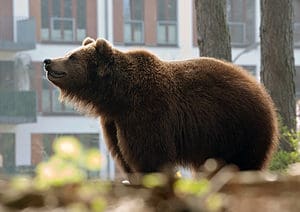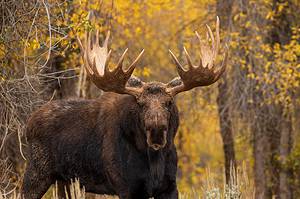Maine, the 23rd state in the United States of America, is nicknamed the pine tree state. It is a beautiful place to visit with plenty of hiking trails and national parks. In the parks, if you are lucky, you can see multiple majestic and large animals. One of the most interesting and tallest animals in Maine is the moose.
It shouldn’t surprise you to know that Maine is a hunting state. There are plenty of opportunities year-round to hunt for moose, but you need the right hunting license and permission. In Maine, there have been some impressive catches. Keep reading to discover the largest moose ever caught in Maine along with other interesting facts!
About Moose

Moose can weigh more than 1,500 pounds.
©Pierre Leclerc/Shutterstock.com
Moose, also known as elk in Eurasia, are large animals in the deer family. They are native to North America, Europe, and Asia. While their range has decreased because of hunting and human activities, they have a stable population, and they are listed as ‘Least Concern’.
Size and Appearance
Moose are unique and have an interesting appearance. These animals have broad open-handed shaped antlers and can weigh more than 1,500 pounds. A male moose, also known as a bull, typically reaches between 4 feet 7 inches and 6 feet 11 inches. Their antlers are just as large with an average antler span past 4 feet. The largest subspecies is the Alaskan subspecies (A. a. gigas). It easily surpasses 7 feet tall with an antler span of 5 feet 11 inches. Female moose, also known as cows, are slightly smaller, but just as impressively big. The average female cow weighs 441 to 1,080 pounds.
Moose are a sight to see, towering over cars and some buildings. They also have short tails that can’t swat away insects. The moose skin is the same as others in the deer family. Their coats also have two layers that vary in thickness and length. The top layer consists of long guard hairs that help them float while swimming. Moose are easy to spot because of their unique appearance and long legs. They use their long legs to wade through snow successfully.
Diet
Despite their appearance, moose are herbivores capable of eating many types of fruits and vegetables. To maintain their massive body weight, an average adult moose consumes 23,000 kilocalories per day. Most of their energy comes from consuming terrestrial vegetation and fresh willow or birch shoots. While moose don’t have upper front teeth, they have eight sharp incisors on the lower jaw. Their tough tongue also helps break down rough plants. Most of the time, moose grasp for their food, stretching their heads up. They also pull plants from the ground like dandelions. Unlike other animals, moose cannot safely consume hay, in some cases it’s fatal.
Predators
It’s hard to imagine these large mammals have natural predators. The largest predator that preys on moose is the Siberian tiger. Still, the threat is not large since there aren’t many wild Siberian tigers left. A pack of wild gray wolves can also pose a threat to moose, especially to vulnerable females with their calves. Another potential predator is the brown bear. Instead of starting a fight though, brown bears join wolves in taking down moose of all sizes. Baby moose, also known as calves, are the most vulnerable. In May and June, black bears and cougars prey on young moose and injured adults.
The Largest Moose Ever Caught in Maine

The largest moose ever caught in Maine scored 220 3/8.
©RT Images/Shutterstock.com
Moose are very common in Canada, but they also travel and live in Maine. According to the Boone and Crocket Club’s record, the largest moose ever caught in Maine scored 220 3/8. In 2002, James T. Robertson caught this massive animal. While it didn’t make Boone and Crocket Club’s official list, another impressive hunt weighed 906 pounds. Alan Stender and John Durkee worked together to track and kill a large moose bull in Maine. The bull was so heavy they didn’t have the proper tools to drag it out! Instead, they called a logger they met who helped them. To preserve the meat, he cut up and froze the moose.
What’s the Largest Moose Ever Recorded?
Over a century ago, a 1,808-pound and 7.6 feet tall moose broke the record for the largest moose ever recorded. Still, one hundred years later, no one found an even larger one. This moose was killed in September 1897 in Yukon and is recorded in the Guinness Book of World Records. That’s almost double the size of the moose caught by Durkee and Stender! Although unconfirmed, some people have stated they’ve killed or found moose larger than 2,300 pounds.
Up Next
- What’s the largest moose ever recorded?
- Discover the Largest Ocean in the World
- Moose vs Car: How Dangerous is a Collision?
- Moose Size Comparison: Just How Big Are They?
The photo featured at the top of this post is © Harry Collins Photography/Shutterstock.com
Thank you for reading! Have some feedback for us? Contact the AZ Animals editorial team.






